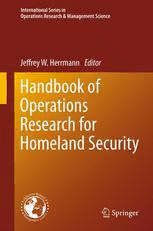
Handbook of operations research for homeland security PDF
Preview Handbook of operations research for homeland security
International Series in Operations Research & Management Science Volume 183 SeriesEditor FrederickS.Hillier StanfordUniversity,CA,USA SpecialEditorialConsultant CamilleC.Price StephenF.AustinStateUniversity,TX,USA For furthervolumes: http://www.springer.com/series/6161 Jeffrey W. Herrmann Editor Handbook of Operations Research for Homeland Security Editor JeffreyW.Herrmann A.JamesClarkSchoolofEngineering UniversityofMaryland CollegePark,Maryland,USA ISSN0884-8289 ISBN978-1-4614-5277-5 ISBN978-1-4614-5278-2(eBook) DOI10.1007/978-1-4614-5278-2 SpringerNewYorkHeidelbergDordrechtLondon LibraryofCongressControlNumber:2012948967 #SpringerScience+BusinessMediaNewYork2013 Thisworkissubjecttocopyright.AllrightsarereservedbythePublisher,whetherthewholeorpart of the material is concerned, specifically the rights of translation, reprinting, reuse of illustrations, recitation,broadcasting,reproductiononmicrofilmsorinanyotherphysicalway,andtransmissionor informationstorageandretrieval,electronicadaptation,computersoftware,orbysimilarordissimilar methodologynowknownorhereafterdeveloped.Exemptedfromthislegalreservationarebriefexcerpts inconnectionwithreviewsorscholarlyanalysisormaterialsuppliedspecificallyforthepurposeofbeing enteredandexecutedonacomputersystem,forexclusiveusebythepurchaserofthework.Duplication ofthispublicationorpartsthereofispermittedonlyundertheprovisionsoftheCopyrightLawofthe Publisher’s location, in its current version, and permission for use must always be obtained from Springer.PermissionsforusemaybeobtainedthroughRightsLinkattheCopyrightClearanceCenter. ViolationsareliabletoprosecutionundertherespectiveCopyrightLaw. The use of general descriptive names, registered names, trademarks, service marks, etc. in this publicationdoesnotimply,evenintheabsenceofaspecificstatement,thatsuchnamesareexempt fromtherelevantprotectivelawsandregulationsandthereforefreeforgeneraluse. While the advice and information in this book are believed to be true and accurate at the date of publication,neithertheauthorsnortheeditorsnorthepublishercanacceptanylegalresponsibilityfor anyerrorsoromissionsthatmaybemade.Thepublishermakesnowarranty,expressorimplied,with respecttothematerialcontainedherein. Printedonacid-freepaper SpringerispartofSpringerScience+BusinessMedia(www.springer.com) This book is dedicated to my family, whose love and encouragement are the most wonderful of the many blessings that God has given to me. Preface Thepurposeofthisbookistoenlightenpolicymakersanddecisionmakersabout thepowerofoperationsresearch(OR)tohelporganizationsplanforandrespondto terroristattacks,naturaldisasters,andpublichealthemergencies. The intended audience includes (1) policy makers and decision makers in federal, state, and local government agencies related to homeland security, emergency management, and public health preparedness; (2) nongovernment organizationswithsimilarmissions;and(3)operationsresearchworkers,students, andscholars. This book begins with a general overview of how operations research can be used and then provides specific examples of operations research techniques and theirapplicationtohomelandsecurityproblems. Chapter 1, “Using Operations Research Methods for Homeland Security Problems,” describes OR techniques and highlights their use to solve homeland security problems. This is intended to give policy makers and decision makers insightintowhatORcandoandhowitisrelevanttotheirparticularconcernsand problems. After discussing how to use OR, the chapter reviews four areas: (1) understandingwhathashappened;(2)consideringwhatcouldhappen;(3)deciding whattodo;and(4)findingthebestsolution. Chapter 2, “Operations Research and Homeland Security: Overview and Case StudyofPandemicInfluenza,”providesadditionalcontextbydescribingtheorigins of operations research (OR) at the beginning of World War II and reviewing OR tools and techniques that can be used for three types of decisions: long range (strategic), medium range (tactical), and real time (operational). It then discusses theresultsofastudyoftheprocessofmanufacturing,delivering,andadministering thefluvaccineduringthe2009influenzapandemic. Chapter3,“DeployedSecurityGamesforPatrolPlanning,”presentsmodelsthat can help security forces generate randomized security policies that are more difficult for adversaries to predict and exploit. The chapter describes a generic mathematical formulation of these models, presents some of the results that have allowed these systems to be deployed in practice, and outlines remaining future challenges.Thechapterdiscussesthedeploymentofthesesystemsintwohomeland vii viii Preface security applications: (1) the police at the Los Angeles International Airport use these models to randomize the placement of checkpoints on roads entering the airport and the routes of canine unit patrols within the airport terminals and (2)theFederalAirMarshalServiceusesthesemodelstorandomizetheschedules ofairmarshalsoninternationalflights. Chapter 4, “Interdiction Models and Applications,” describes an approach for assessingthevulnerabilitiesofoperationalsystems.Interdictionmodelscanbeused to answer the following questions: How is the system operated? What are the vulnerabilities of that system? How can we invest to make the system more resilient?Thischapterdiscussestheapplicationofthesemodelstofourproblems: (1) delaying an enemy’s development of a nuclear weapon; (2) understanding the vulnerabilities of an electric power system; (3) locating sensors that can rapidly detect the contamination of a municipal water system; and (4) locating radiation sensors to detect nuclear smugglers. The chapter also discusses practical implicationsandinsightsobtainedfromthemodelsintheseapplications. Chapter5,“TimeDiscrepantShipmentsinManifestData,”presentsaninnova- tive data mining technique for identifying suspicious activity by identifying and recordingunusualpatternsthathavehighactivity.Thechapterfocusesoncontainer shipments to US ports. By analyzing the origin–destination pairs, container contents,andshipmentdates,theprocedurecreatesavarietyofgraphstovisualize theshipmentactivity,measuresthediscrepancyofshipmentpatterns,anddistillsa datafossilthataggregatesthesepatternsovertime. Chapter 6, “Achieving Realistic Levels of Defensive Hedging Based on Non-Monotonic and Multi-Attribute Terrorist Utility Functions,” addresses the problem of allocating limited resources to defend a set of targets. When there is uncertainty about which targets the terrorists are most likely to attack, decision makers are likely to insist on some degree of “hedging” (defending targets with onlymoderatevalue).Theworkdiscussedinthischapterusesgametheorytofind the optimal strategy for the defender and shows that non-monotonic attacker objectivefunctionsdotypicallyyieldgreaterhedging. Chapter 7, “Mitigating the Risk of an Anthrax Attack with Medical Countermeasures,” presents a simulation model that can be used to prepare for a bioterrorismattackthatreleasesanthraxsporesandexposesthousandsofpersonsto this deadly disease. The model predicts the expected number of deaths using information about the sizeof the population, the number exposed,the progress of thedisease,theresourcesavailablefordistributingmedicationandtreatingtheill, and the size of local medication stockpiles. The chapter also presents a risk management approach for allocating a limited medication stockpile to multiple citiestominimizetheexpectednumberofdeaths.Theresultsshowthattheoptimal allocationcanbequitedifferentfromallocationsthatareproportionaltopopulation size. Chapter 8, “Service Networks for Public Health and Medical Preparedness: Medical Countermeasures Dispensing and Large-scale Disaster Relief Efforts,” discussestheresultsofcollaborationsbetweenORexperts,theCentersforDisease ControlandPrevention,andotherpublichealthagenciestodevelopusefultoolsfor Preface ix planningeffortstorespondtopublichealthemergencies.Suchemergenciesinclude bioterrorismattacks,naturallyoccurringpandemics,andseveremeteorologicaland geological events. In paricular, the chapter describes OR models for optimizing massdispensingoperations. Chapter 9, “Disaster Response Planning in the Private Sector and the Role of Operations Research,” discusses how organizations in the private sector can be effective first responders in the aftermath of disasters. The chapter describes the disaster response planning process implemented by The Home Depot, discusses the role of OR methods to assist decision making, and presents an optimization modeltoimproveadvancepurchasingandinventoryallocation. This book is the result of a team effort. The authors who contributed their valuabletimetoproducetheinformativechaptersthatcomprisethisvolumemust bethankedfirst.Iappreciatetheirefforttodevelop,write,andrevisetheirchapters andcompletethenecessarysupportingtasks. IwouldliketothankFredHillierforinvitingmetoeditthishandbook,foritisan honor to be a part of this distinguished series. My thanks also go to Matthew Amboy,whoguidedtheprocessoftransformingourchaptersandideasintoabook. In addition to caring for our family, my wife Laury provided useful editorial assistance, and I appreciate the time and effort that she spent helping me on this project. Finally, I am indebted to my generous family and the wonderful friends, colleagues, teachers, and students who have shared their wisdom, energy, and talentswithme. Maryland,USA JeffreyW.Herrmann
